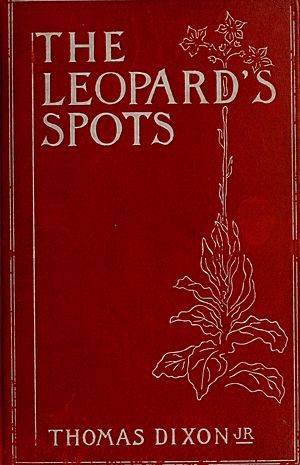The Leopard's Spots facts for kids

First edition cover
|
|
| Author | Thomas Dixon |
|---|---|
| Illustrator | C. D. Williams |
| Country | United States |
| Language | English |
| Genre | Novel |
| Publisher | Doubleday, Page & Co. |
|
Publication date
|
1902 |
| Media type | |
| OCLC | 12852953 |
The Leopard's Spots is a novel written by Thomas Dixon, published in 1902. It is the first book in his "Reconstruction trilogy." This series of books tells stories set during the Reconstruction era (1865-1900). This was the period after the American Civil War when the Southern states were rebuilt.
In The Leopard's Spots, Dixon presents his view of this time. He shows certain leaders, people from the North called "carpetbaggers," and formerly enslaved people as the bad guys. Members of the Ku Klux Klan, a secret group, are shown as heroes. The book's title comes from a Bible verse: "Can the Ethiopian change his skin, or the leopard his spots?" Dixon used this idea to suggest that people of African origin could not change what he believed were negative traits. This view is part of a belief system called white supremacy, which claims one race is better than others.
Contents
Responding to Uncle Tom's Cabin
In 1852, Harriet Beecher Stowe wrote a very famous book called Uncle Tom's Cabin; or, Life Among the Lowly. This novel greatly influenced how people in the U.S. thought about African Americans and slavery. Many believe it helped lead to the Civil War. Even 50 years later, it was still widely read.
Thomas Dixon felt that Stowe's book did not show the American South accurately. He also disagreed with how she presented African Americans. Dixon wanted to write his own story to "answer" Stowe's book. To make this clear, he used some of the same character names from Uncle Tom's Cabin in his own novel.
Main Characters in the Story
Here are some of the important characters in The Leopard's Spots:
- Charles Gaston – A man who hopes to become the Governor.
- Sallie Worth – A young woman from the traditional Southern way of life.
- Gen. Daniel Worth – Sallie's father.
- Mrs. Worth – Sallie's mother.
- The Rev. John Durham – A preacher.
- Mrs. Durham – A woman who represents the Southern spirit.
- Tom Camp – A Confederate soldier who lost a leg in the war.
- Flora – Tom's young daughter.
- Simon Legree – A former manager of enslaved people and a leader during Reconstruction.
- Allan Mcleod – A Southerner who supported the Reconstruction government, sometimes called a "scalawag."
- Hon. Everett Lowell – A member of Congress from Boston.
- Helen Lowell – His daughter.
- Miss Susan Walker – A woman from Boston.
- Major Stuart Dameron – The leader of the Ku Klux Klan.
- Hose Norman – A brave poor white man.
- Nelse – A Black character from the older way of life.
- Aunt Eve – Nelse's wife, described as a "respectable woman."
- Hon. Tim Sheldby – A powerful political leader in the new era.
- Hon. Pete Sawyer – A character who was sold multiple times.
- George Harris, Jr. – An educated Black man.
- Dick – A mysterious character.
Characters with Names from Uncle Tom's Cabin
Dixon used some names from Stowe's famous novel, but he changed their roles:
- Simon Legree – In Stowe's book, he was a very cruel slave master. In Dixon's book, he is a leader during Reconstruction.
- Tom Camp – In Stowe's novel, Tom was a humble enslaved African American. In Dixon's book, Tom is a white former Confederate soldier whose family faces hardship.
- Hon. Tim Shelby – In Uncle Tom's Cabin, Arthur Shelby was Tom's owner. In Dixon's book, Tim Shelby is a political boss.
- George Harris, Jr. – In both books, he is an educated Black man.
Play Version
Thomas Dixon also created a play based on The Leopard's Spots. This play was performed in New York in 1913.

